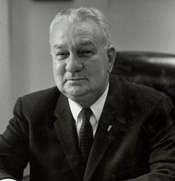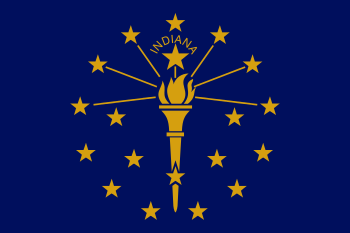Charles A. Halleck
| Charles A. Halleck | |
|---|---|
 | |
| House Majority Leader | |
|
In office January 3, 1947 – January 3, 1949 | |
| Deputy | Leslie C. Arends |
| Preceded by | John W. McCormack |
| Succeeded by | John W. McCormack |
|
In office January 3, 1953 – January 3, 1955 | |
| Preceded by | John W. McCormack |
| Succeeded by | John W. McCormack |
| House Minority Leader | |
|
In office January 3, 1959 – January 3, 1965 | |
| Deputy | Leslie C. Arends |
| Preceded by | Joseph W. Martin |
| Succeeded by | Gerald Ford |
| Member of the U.S. House of Representatives from Indiana's 2nd district | |
|
In office January 29, 1935 – January 3, 1969 | |
| Preceded by | George R. Durgan |
| Succeeded by | Earl F. Landgrebe |
| Personal details | |
| Born |
Charles Abraham Halleck August 22, 1900 DeMotte, Indiana, U.S. |
| Died |
March 3, 1986 (aged 85) Lafayette, Indiana, U.S. |
| Political party | Republican |
| Education |
Indiana University at Bloomington Indiana University Maurer School of Law - Bloomington |
| Profession | Lawyer |
| Military service | |
| Allegiance | United States |
| Service/branch | United States Army |
| Battles/wars | World War I |
Charles Abraham Halleck (August 22, 1900 – March 3, 1986) was an American politician. He was the Republican leader of the United States House of Representatives from the second district of Indiana.
Early life and education
Halleck was born near DeMotte, in Jasper County, Indiana, the son of Abraham and Lura (née Luce) Halleck. He served in the infantry of the United States Army in World War I. After military service, Halleck attended Indiana University at Bloomington. In 1924, Halleck was admitted to the bar and began practicing in Rensselaer, Indiana. From 1924 to 1934, he was the prosecuting attorney for the 13th district court.
Career
Following the death of Frederick Landis in 1935, Halleck replaced him and remained in that position until 1969. A prominent member of the conservative coalition, he served as the House Majority Leader after the elections of 1946 and 1952. He was House Minority Leader from 1959 to 1964.
Halleck noted that a highlight of his career came at the 1940 Republican National Convention, when he nominated another person from Indiana, Wendell Willkie. Noting the mixed reception he got, Halleck said, "I got more brickbats and more bouquets over that speech than any other I've ever made."[1]
In 1944, even before Thomas Dewey was named as the Republican presidential nominee, Halleck, as the new chairman of the National Republican Congressional Committee, addressed a party gathering in Chicago. He rejected the Democrat "don't-change-horses-while-crossing-the-stream" mantra and declared that a Republican president would retain George C. Marshall, Dwight Eisenhower, Douglas MacArthur, and William F. Halsey in their military positions. He attacked what he called the New Deal "snooping into our ice boxes," a reference to the Office of Price Administration and rationing. Halleck said that Americans should "live again as God meant us to live and not as some bureaucrat in Washington... would like us to live."[2]
According to Halleck, he was rumored to be Thomas Dewey's vice-presidential nominee in Dewey's second general election campaign in 1948 if Halleck guaranteed the support of the Indiana delegation at the 1948 Republican National Convention. In the end, Dewey selected the governor of California, Earl Warren. The Dewey-Warren ticket surprisingly narrowly lost that November, to the Democratic Truman/Barkley ticket.[3]
In 1959, with the declining popularity of Eisenhower enabling Democrats to maintain their hold on the House, Halleck parlayed his following among Congressional Republicans and the frequent public approval of Eisenhower and Richard Nixon, into a successful challenge to the 20-year reign of Joseph W. Martin, Jr., as the leader of House Republicans.[4]
He was a strong opponent of the liberal social proposals of Democrats John F. Kennedy and Lyndon Johnson but supported the Vietnam War and was one of the strongest advocates for the Civil Rights Act of 1964. Along with Senator Everett Dirksen, he was the face of the Republican Party in most of the 1960s, and both made frequent appearances on television news and talk programs. The press jocularly nicknamed his joint appearances with Mr. Dirksen the "Ev and Charlie Show."
After the heavy election setbacks of 1964, Halleck was defeated in his bid to remain Minority Leader by Gerald Ford, who was the leader of a younger, more moderate faction.
Legacy
In 1983, U.S. President Ronald W. Reagan signed a bill renaming the Federal District Court building in Lafayette, Indiana, the Charles A. Halleck Federal Building.[5]
The Charles Halleck Student Center at Saint Joseph's College in Indiana was named after him.[6] It was listed on the National Register of Historic Places in 2016.[7]
Personal life
Halleck was married to the former Blanche Annetta White, who died in 1973. They had two children. His son, Charles A. Halleck Jr., first became an attorney in Washington, DC, and later a United States federal judge.
Death
Halleck died in Lafayette, Indiana, on March 3, 1986 and is buried next to his wife in Rensselaer.
In popular culture
- Halleck was portrayed by actor Arthur Franz in the 1974 made-for-television film, The Missiles of October, a dramatization based on John F. Kennedy and the Cuban Missile Crisis.
References
- ↑ "Charles Halleck Obituary". Toledo Blade. Mar 4, 1986. Retrieved Jun 11, 2014.
- ↑ David M. Jordan, FDR, Dewey, and the Election of 1944 (Bloomington and Indianapolis: Indiana University Press, 2011), p. 78, ISBN 978-0-253-00562-5
- ↑ Heise, Kenan (March 4, 1986). "Ex-gop House Boss Charles Halleck, 85". Chicago Tribune.
- ↑ Franklin, Ben A. (Mar 4, 1986). "CHARLES HALLECK, A G.O.P. HOUSE LEADER, DIES". New York Times. Retrieved Jun 11, 2014.
- ↑ "Divisional Offices - Hammond Division at Lafayette".
- ↑ http://www.newsbug.info/rensselaer_republican/sjc-to-celebrate-halleck-center-s-th/article_bc7b0862-fabb-11e1-a468-001a4bcf887a.html
- ↑ "National Register of Historic Places Listings". Weekly List of Actions Taken on Properties: 6/06/16 through 6/10/16. National Park Service. 2016-06-17.
Further reading
- Peabody, Robert L. The Ford-Halleck Minority Leadership Contest 1966;
- Scheele, Henry Z. Charlie Halleck: A Political Biography. Exposition Press, 1966.
External links
- United States Congress. "Charles A. Halleck (id: H000081)". Biographical Directory of the United States Congress.
- Charles A. Halleck at Find a Grave
| United States House of Representatives | ||
|---|---|---|
| Preceded by George R. Durgan |
U.S. Representative of Indiana's 2nd Congressional District 1935–1969 |
Succeeded by Earl F. Landgrebe |
| Party political offices | ||
| Preceded by John W. McCormack |
House Majority Leader 1947–1949 1953–1955 |
Succeeded by John W. McCormack |
| Preceded by Joseph W. Martin |
House Minority Leader 1959–1965 |
Succeeded by Gerald Ford |

